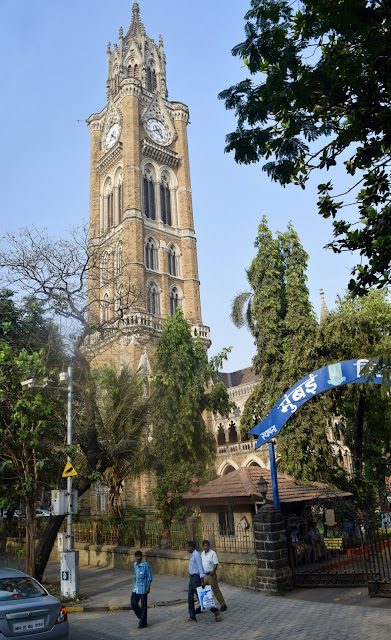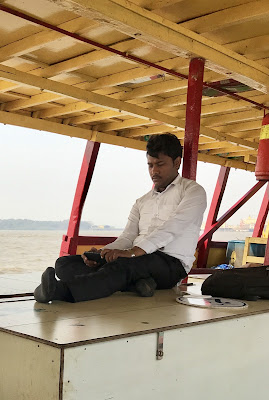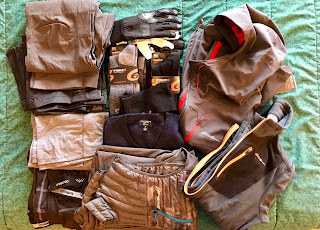2018 "Song of India" Adventure - Day 15 - Mumbai, India
Day 15
– Tuesday, March 6th – Mumbai, India
(Allan writing) Remember what I said in
an earlier post about letting go of preconceptions? Just so. ;-)
Yes,
as we sailed into the Port of Mumbai the bay was choked with ships either
anchored or waiting for berth at the docks. Yes, the air was thick with
pollution and the first impression you had was of a heavy petrochemical odor.
After a few minutes of breathing this air the back of your throat was a bit
sore, but you no longer noticed the smell – as much.
 |
| First view of Mumbai |
I
know Steve was very concerned that I would be seriously put off by the level of
poverty and the density of population that we were to see here, but honestly –
it wasn’t that bad; not where we were, anyway. Yes, there were people begging,
but not like what we saw in Italy or Greece. Yes, there were people who were
very poor and possibly starving; not as bad as what we saw on the streets of
Colombo, Sri Lanka. There was only one point in the day where I got a really
clear idea of what an average snapshot of “life in Mumbai” may have really
looked like. We were on the bus just having left the main train station area
where we got out and took pictures. As we were driving back to the Port, we
passed an extremely crowded side street,
the kind of crowd I’ve only seen a few times in my life. The street was like a
sea of people, undulating back and forth from one end to the other, several
blocks away. On either side of the street rose what looked like tenement
apartments, rising at least six stories with tiny shops on the street level,
cars crowded against the sidewalks… I was so struck by this scene that I forgot
(and instantly regretted) to take a picture. I think I won’t need the picture,
as it would be difficult to forget that moment. That was what this place (and much of Asia, I imagine) was about:
enormous crowds of people vying for limited space and resources in grueling
heat, sweat, and stink. Life - clinging
as best as it can, eeking out what it may, given the circumstances it has. This
is the lesson I learned here: the tenacity of life.
On
with the adventure…
(SW: This was the second of two tours
arranged through the cruise line, the prior one being in Phuket) . We left
the ship and trundled off to our bus for the Elepanta Island tour. Our guide
for this tour was an older Indian gentleman, probably about 60, with a thick
accent. When he found out that we had a Spanish speaking couple, he told us
that he would be moderating his speech – slowing it down, to the point that we
could barely follow some of his narrative about what we were seeing. Oh well.
;-)
On
our way to the Gateway of India, we followed a few narrow
streets out of the Port area into the city of Mumbai proper: a frantically
bustling place filled with cars, scooters, and busses – all honking. This was a
stark contrast to Singapore, where no one honked their horns. Somehow all the
traffic seemed to move – slowly.
We
got to the Gateway of India and followed our guide across the busy street and filed through
the entrance area – one lane for men and one for women. Some of the women in
our group got confused and refused to join the other line. No matter. We all
came in to the area where you wait for your ferry over to Elephanta Island. The
bay was filled with charming, colorful, double-decked ferries bobbing around in
the water. People crowded around the pier waiting their turn. Some vendors
tried their best to sell us maps, postcards, and guides for the island. They
weren’t really obnoxious about it. I have yet to see anyone as obnoxious as the
vendors in Istanbul: you learned very quickly to not even acknowledge them, or
you’d never be rid of them.
 |
| Gateway of India, Mumbai |
We
snapped a few pictures as best we could of the Gateway of India: a large building (think
Paris’ Arc de Triomphe scaled to half-size), built in 1911 in tribute to the
royal visit to India by England’s King George V and Queen Mary. It was hard to photograph
because we were so close to it, and the actual building itself was cordoned off
by a thick metal chain – no entry allowed.
After a few minutes, we were loaded
on to one of the ferries, stepping through another boat that acted as our
intermediate dock (quite tricky for some, as both boats were moving constantly
– bobbing around as I mentioned before). Steve wanted to sit upstairs, which
was fine with me. A good choice, as there was a nice breeze that blew up there
throughout the journey to the island, about a 45-minute trip (outbound).
(SW: The boat was only occupied by our group of 25,
which was a luxury. That Spanish-speaking couple Allan referred to was a young husband
and wife from Mexico City. The husband was photographing everything!)
There
were a great many ships in the bay, many of which we weren’t really certain
what their purpose was due to strange (to us) superstructures built up on their
decks. We did pass by an artificial island built to offload crude oil and send
it via underground pipeline to a refinery many miles away onshore.
 |
| Dredging in Mumbai Harbor |
After
we funneled through a series of vendors lining either side of the walkway, we
got to the main gate and our guide paid our entry fee: 30 Rupees for Indian
natives ($0.46) and 500 Rupees for foreigners ($7.68). When we were all through
the entrance gate our guide called us together to explain a few guidelines and
expectations. He had a very irritating way of getting the group’s attention: he
would call out “Hello hello hello!” as if we were a bunch of three year olds.
Well, whatever works – and it did. ;-) After telling us where we would all meet
up when the tour was complete he bade us start climbing.
The
stairs to the caves area were a long, broken walk – all with a slight-ish
incline, mostly covered with a fabric tent. Remember, it was now about 33-35C
and extremely humid. The walk up the hill was arduous, and while walking you
were being bombarded by vendors on both sides trying to vie for your attention.
 |
| Shivas, Ganeshas, and Vishnus, oh my! |
We were not distracted, and made it up to the top in about 20 minutes. Once
there, we rested, took in the view, and saw our first real concentration of
monkeys. They were everywhere. They were ragged creatures, eager to grab on to
whatever they could and carry it off – food especially. (SW: Seriously skanky-looking monkeys. Not the cute ones from Costa
Rica.). I bought a large bottle of very cold water from a vendor for a
dollar, and once everyone was with us at the top we continued on to the caves.
 |
| An example of one of the seriously skanky monkeys. Look at that come hither pose! |
Just
a short walk from the top of the hill climb, the first of the caves was easily
the most impressive. It was a Hindu temple, one of five, carved from the
outside in – through solid rock. (SW:
They date back to AD 5th-7th century). The entrance
was about 50 feet wide, with stairs carved out leading up to it and several
pillars carved out as well. At its highest point, the cave ceiling was about 20
feet high. There were nine “panels” carved in to the rock, telling the story of
the life of Shiva: the Hindu god whose temple this was. The panels were
magnificent achievements in artistry and workmanship, but many of them had been
defaced by the Portuguese, who re-discovered the caves after they lay dormant
and unused for over 400 years. It made me sad. (SW: We were told that some of the carvings were used for target
practice. Even sadder.)
 |
| Entrance to one of the Hindu caves, Elephanta Island, Mumbai, India |
 |
| To think this was carved with chisels and hammers nearly 1500 years ago from the outside in! |
 |
| Three faces of Shiva |
 |
| Shiva the Destroyer |
Our guide gave us an explanation of the meaning of each of the panels in sequence, asking us to stay together (hello hello hello!) until he was finished and then he would release us – for 30 minutes, to take photographs and go see the rest of the five caves and two more Buddhist caves up above on another level! Ha! We were not pleased that we were given such a short amount of time but what can you do? We dashed around to the other four Hindu caves, which honestly were not anywhere near as impressive or as ornately carved as the first. (SW: Yet, there was still something worth seeing in a couple of them).
 |
| The view of Cave 4 from Cave 5, Elephanta Island, Mumbai, India |
(SW: Maybe it was the heat or something, but
I hypothesized to Allan that after all the tourists were gone and the vendors
packed up, the monkeys would hop on the dogs and have races.)
At
2:45PM we were to be back down the hill, meeting at the bottom of the steps.
The vendors were much more aggressive
on the way down, and at one point about two-thirds of the way down Steve
stopped to inquire about an Om bowl (used in meditation – or just for the
beautiful bell-like sound they make when you run a wooden bar around the rim –
similar to the sound your moistened finger makes as you run it around the rim
of a fine quality wine glass). This was the only real souvenir Steve wanted and
he started haggling with one of the vendors and I had to call him away, saying
we only had 3 minutes to get down the rest of the stairs. (SW: Yes, dear reader, one of the few times in our history when Allan
had to pull me away from shopping.)
We made it to our group, barely on time.
As
we waited for everyone to arrive, a large black bull who had meandered down the
hill, sort of with us, decided to take a fancy to one of the women in our
group. He kept sort of nuzzling her and she had to keep moving away from him as
we all moved toward the train boarding area.
Steve
decided he wanted to walk back to the pier along the causeway instead of
waiting for the train, so we did (SW: And
the bull joined in as well). We made it back shortly before the train did,
and after a short wait, filed back onto our boat to head back to Mumbai.
I
think it had cooled down to about 92 degrees as we moved out across the bay
back to the city. I was very tired, but had cleverly brought snacks this time –
a nice crispy French roll, a couple of tiny croissants, and some raisins from
the ship. I did not want a repeat of my episode in Goa the day before. We
shared the croissants and I ate the roll and a few raisins, and then I slept
for a bit. (SW: I, on the other hand,
kept my gaze on the handsome assistant tour guide!).
When
I awoke, we were past the island where they offloaded the crude oil and we had
about 10 more minutes on the boat. Unfortunately, the sun was almost directly
behind the India Gate so there would be no more photos of that taken this day.
After
we got off the boat, it was around 4:00PM. There was some drama surrounding
more possible stops we might make on the tour before heading back to the Port.
It was finally decided that we’d make one more stop – at the main train
station, to take photos, then proceed to the Port. The traffic between the Gate
and the train station was quite heavy; much honking of horns everywhere. We
passed by the incredibly beautiful old Mumbai University, built by the British
in 1870 (then named University of Bombay).
 |
| Mumbai University |
Shortly
after passing the University, we stopped and got out of the bus – across the
street from the main train station: another incredibly beautiful, ornately
decorated, Victorian era building. Easily one of the largest train stations I’ve
ever seen, this place has 20 platforms and moves 2 million people a day!
 |
| Victoria Station (former), Mumbai, India |
We
remained at our viewpoint for about 20 minutes, taking photos and listening to
our guide’s explanation of a little of the history of the station, then moved
across the very busy street and waited for a few minutes for our bus to return
(it had gone around the block, as it were, because there was nowhere for it to
park on the side of this very busy thoroughfare). As we re-boarded the bus,
there were a couple of women demanding that we give them a dollar – for what
were we supposed to be paying them, I do not know. (SW: Allan forgot to mention the two women at the top of the steps on
Elephanta Island who were dressed in saris with water jugs on their head,
yelling “Photo! Photo! Photo!”. But if you took a photo of them, they expected
money. What a racket!)
The
rest of the ride to the port was of very little interest, except for the moment
I described at the beginning of this entry, where I gained some small, but
clear understanding about the nature of humanity in this part of the world. What
I didn’t mention above was that I’ve seen parts of the world where there’s been
continuous human habitation for well over two thousand years (Rome, Istanbul,
etc.), but they just didn’t have the same flavor of antiquity that this place
did. Maybe that sounds odd, but there it is.
We
departed from our tour and went in to the cruise terminal, finding nothing we
needed to purchase in the way of last minute souvenirs, and headed back to the
ship, saying farewell to India!
Once
again, we had dinner at Blu, but since we didn’t get there until 9:15PM, we
were the last ones there when we left at 10:30PM.



Comments